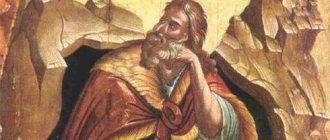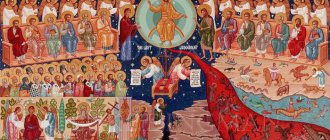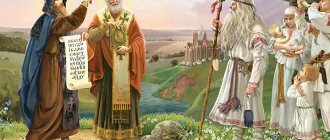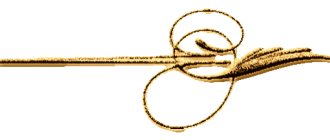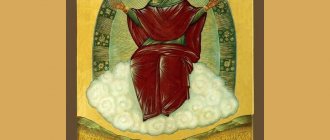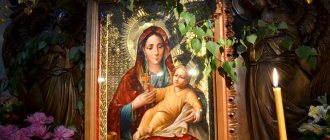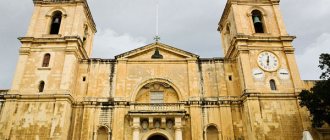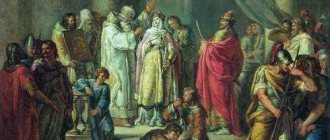Savior the Good Silence is a rare icon of Christ. If “Savior Emmanuel” and “Savior Not Made by Hands” depict Christ as he was on earth, and “Savior in Power” – as he will come at the end of time, then “Savior Good Silence” is Christ before His coming to to people. And this is the only image of Christ where an eight-pointed star is written in the halo instead of a cross.
The star is formed by two squares, one of which denotes the divinity of the Lord, the other marks the darkness of the incomprehensibility of the Divine. The Savior is depicted in angelic rank as a young man wearing a white dalmatic (robe) with wide sleeves. His hands are folded and pressed to His chest, His wings are lowered behind His back. The icon conveys the angelic image of the Son of God - Christ before the incarnation, the Angel of the Great Council.
The history of the appearance of the image of the Angel of Silence
The holy face of Jesus Christ before his appearance to people was first depicted in the form of a fresco in the Assumption Cathedral of the Moscow Kremlin in the 15-16th century. The same icon appeared in the Church of the Savior on Spilled Blood in St. Petersburg, then in the Rostov and Yaroslavl regions.
The next mention of this icon dates back to the beginning of the 20th century, when it was painted specifically for the St. Petersburg Church of the Savior on Spilled Blood, erected in 1907 at the site of the death of Emperor Alexander II, who fell at the hands of terrorists. Somewhat later, similar images appeared in some churches in the Yaroslavl and Rostov regions.
The content of this icon, according to one interpretation, is based on the prophecy of Isaiah, which says: “I trust in Him, who will proclaim the truth to the nations. He will not cry out or complain, but His voice will be heard in the streets” (Isa. 42: 1 – 2). In another interpretation, this image symbolizes humility, silent inaction in the face of suffering and death.
The icon of “Savior the Good Silence” enjoyed special veneration among monasticism, serving as an example of the feat of silence and “mental prayer” that flourished on the holy Mount Athos in the Middle Ages. The psalmist David said: “Lord, set a guard over my lips and guard the doors of my mouth.”
The Monk Isaac the Syrian argued that words are the instrument of this world, and silence is the secret of the future age. Priest Sergius Kruglov writes: “The silence of the great temple. That silence, not silent, but filled with the presence of the Spirit, the laboring creative movement of the Spirit, the life-giving silence in which God created the world.” It was precisely to gain this silence from the “noise of passions” of their own “I” that Orthodox ascetics went into the forests and deserts.
N.K. dedicated lofty, inspired words to the Image of the Savior. Roerich in the article “Power of Light”:
“Angel of Good Silence.” Who has not admired the fiery mystery in the form of a fiery Angel? Who has not bowed before the all-pervading message of this long-awaited and unexpected Guest? He is silent, like a heart that has comprehended. It contains the imperishable beauty of the spirit. Beauty is in the eternity of a silent and meek spirit - it both protects and guides. “An angel is intangible, fire-like, flaming,” says the Mirror*. “It does not require a tongue to speak and an ear to hear; without a voice or hearing a word, one gives his own reason to another. “The dreamy body is put on by angels to appear to people.”
In the silence there was a vision. Objects were filled with light. And the face of the Great Guest shone. And He closed His lips, and crossed His hands, and every hair of His hair streamed with light. And His eyes shone with bottomless intensity.
With care, the Fiery One brought the news of a renewed, blessed world. By secrecy He gave a sign for good. In boldness He reminded of the Ineffable. Tirelessly, during the hours of the day and night, He awakens the human heart. He speaks an order for the victory of the spirit, and everyone will understand and accept it in the language of their heart.
The icon of “Good Silence” is especially widespread among monasticism, serving as an example of the feat of silence and “mental prayer” that flourished in St. Mount Athos in the 14th century. The psalmist David says: “Put a guard over my lips, O Lord, and guard the doors of my mouth” (Ps. 140:3). In the second half of the 19th century, the almost unknown previously plot of “Savior’s Good Silence” began to be widely reproduced in Old Believer copper casting.
When applied to “Good Silence”, the words of Fr. Pavel Florensky, expressed by him in relation to the icons of Sofia. Sophia's silence is depicted not by closed lips and a finger placed on them, but by folded hands on her chest. This is a sign not so much of silence as of inaction.
Such Silence is a symbol of unspokenness, non-manifestation, non-embodiment. Sophia is the unspoken Logos. The silence of Sophia is a symbol of the non-incarnation of the Eternal Logos, and Sophia Herself is the Logos before the Incarnation. Thus, the icon “Savior the Good Silence” is an image of Jesus Christ before His Nativity.
Interesting! The vision of the Teacher was described by the Apostle Peter in his epistle, characterizing Christ with imperishable beauty and a meek and silent spirit.
Work
The theme of silence, its necessity, becomes one of the key ones in the work and life of Olga Berggolts. The poem “Excerpt” was written by the poetess in 1952. It is a look into the siege past. The theme of silence is the leading one. The poetess always worried that she did not have the opportunity to speak about military truth out loud.
Monument to the Muse of besieged Leningrad in St. Petersburg
The poem is extremely autobiographical and confessional. It is based on the author’s personal experiences and facts from Bergholz’s life. One day, the poetess’s mother gave her the icon “Angel of Good Silence,” which Olga kept all her life. Silent hope, resignation, which this icon symbolizes, prayer in front of this image, helped Bergholz not die during the war years. She spoke loudly in her forbidden diary, which was published only at the beginning of the 21st century. She wrote: “Today Kolya will bury these diaries of mine. Still, there is a lot of truth in them... If I survive, they will be useful to write the whole truth.”
Page from Bergholtz's diary
There are several mysterious lines in the poem: Bergholz writes that the angel of Good Silence twice turned her away from the path. It is impossible to say with certainty what the author means. But we are definitely talking about events in which Olga saw God’s Providence. It is possible that here she recalls not only her stay in besieged Leningrad, but also the pre-war repressions, when the poetess was arrested twice.
Description of the holy image
A unique distinctive feature of this image is the double nymphs surrounding the head of Christ, emphasizing His Divine and human principles. This is the only one of its kind face of Jesus Christ with such an image of halos. The baptismal halo is characteristic of the Savior, who came to earth and gave humanity hope for eternal life.
The Star of Eternity is a sign that Christ in the form of an Angel belongs to the Great Council. The star is formed by two squares, one is a symbol of the divinity of the Most High God, the other is a symbol of the incomprehensibility of the Majesty of God. The ends of the halos are decorated with Greek letters that make up the monogram “Existent.”
Christ’s clothes shimmer with a golden radiance; precious stones and pearls are scattered along the edges; the gold of the shoulders emphasizes that Jesus belongs to the royal family. The Savior's long hair is divided into two strands; they flow smoothly to his shoulders.
Important! Snow-white decoration symbolizes purity, sublimity, ethereality, which is a characteristic of Angels, especially at the moment when they stand before the Throne of the Lord.
The Savior is dressed in a snow-white surplice, the clothing of priests. The surplice symbolizes the Most Pure Flesh of Jesus Christ, His Transfiguration and Resurrection. The bands of the surplice are a symbol of the bonds of Christ; the Savior was bound with them when He was judged.
The eyes of the Savior also look unusual. His look is not filled with severity or sadness, which is inherent in other icons of the Savior. Looking at the unique image, one gets the feeling that the Lord is looking inside Himself.
The arms of the Angel of Light crossed on his chest express submission, patience, and readiness to accept everything given by God the Father. Behind the shoulders of the Angel of Light are wings folded in submission. Orthodox monks in this image find confirmation of the hesychasm that underlies their life.
Hesychasm is a deep practice filled with:
- calm;
- peace;
- liberation;
- silence;
- peace in solitude.
Interesting! Hesychasm grants not only the purification of the soul and spirit. In unceasing prayer, silence and invocation of God's name, a person approaches angelic life; their assistant is the Angel of Good Silence, Jesus Christ.
In a unique image, it acquired particular relevance in Russia in the 18-19th century; researchers of Orthodox values emphasized the deep meaning of the holy face, emphasizing that the icon depicts the Messiah, the Redeemer, whom the prophet Isaiah spoke of as the coming King.
Angel with double halo
As mentioned above, on it Jesus Christ is represented as a bright angel, and not in human flesh, which He accepted in order to atone for original sin through suffering. It was about Him that the prophet Isaiah spoke in his prophecy regarding the coming of the Messiah to the world. This is the main feature of the image.
In addition, its distinctive feature is a double halo, consisting of a circle in which a religious symbol is inscribed - the eight-pointed “Star of Eternity”, consisting of two intersecting squares.
It is generally accepted that one of them symbolizes the divinity of the Almighty, and the other - His incomprehensibility for people. At the ends of the star are often depicted Greek letters that make up the word “Existent,” that is, existing.
A few simple but expressive details
According to established tradition, the figure of the Savior is depicted dressed in a snow-white chiton, the color of which serves as a symbol of purity and innocence. At the same time, the straps (edgings of the sleeves) are perceived by believers as the bonds that tied Jesus during the unrighteous trial carried out on Him by Pontius Pilate.
The eyes of the Savior also attract the attention of the viewer. Unlike other images, where His gaze is filled with severity and sadness, in the icon “Good Silence” the angel seems to be looking inside Himself, preparing to accept everything destined for Him by God the Father. The feeling of the highest submission and humility is conveyed to the viewer by the arms crossed on the chest, as well as the wings folded behind the back.
It is characteristic that Orthodox monks see in the icon “Good Silence” a visible personification of hesychism - the spiritual practice underlying their life, consisting of tranquility, withdrawal from the world, silence, peace and liberation from carnal passions. This helps monks to get closer to angelic life while still in the flesh, and this image serves as a guiding star for them.
The meaning of the holy image
The significance of the icon, on which the Savior is represented in the image of an Angel, is unusually great, since in it His entire theological concept is revealed with extraordinary completeness and at the same time laconicism. First of all, the Savior Emmanuel appears before the viewer - the Eternal Logos, that is, that Will of God, without Which the world could not be created.
In addition, He is also the sacrificial Lamb, who washed away human sins with His blood. In addition, the snow-white surplice in which Jesus is dressed indicates to the audience that this is a priest leading them to unity with the Creator.
The icon of Our Savior the Good Silence is especially loved and revered by Orthodox monks . But the meaning of arms crossed on the chest is direct, as if saying “no,” and denotes that very silence, not the desire to judge, rant, and at the same time, expectation.
It is this interpretation that reveals the patient image of Jesus, ready to wait for the moment of sincere repentance of sinners for the sake of salvation. In addition, there is an assumption that the icon of the Angel of Good Silence reflects not just silence, but shows the quiet humility with which the Son of God experienced suffering and accepted death. The icon serves as an example of fortitude and mental prayer, when words are unnecessary and only the inner voice makes a request.
This image combines:
- Eternal Logos - Emmanuel;
- The embodiment of the word of God in the Lord's Wisdom;
- the sacrificial death of Christ - the Lamb of God;
- Jesus is the priest who led humanity to union with the Creator through the Eucharist.
In the bright face of the Angel one can read the long-suffering with which the Savior waits for the most sinful person on earth to turn to Him.
Through folded hands in meekness, the idea of long-suffering is conveyed; in good silence, Christ awaits sinners, opening the doors for them to repentance and salvation. The Old Believers saw in the icon “Savior the Good Silence” an image of Old Believers who are forced to remain silent under the dominant Church. This image is a reflection of the silent humility with which Jesus walked all the paths of suffering and death.
Another important detail is the long-suffering with which the angelic face of the Savior is filled. It testifies that He is ready to wait for all earthly sinners to turn to Him, regardless of the severity of their deeds.
An example of this is the Prudent Thief, crucified on the cross at the right hand of Jesus Christ and, due to the repentance brought, became the first person to gain the Kingdom of Heaven.
Author
Olga Feodorovna Berggolts (1910–1975) was called the muse of besieged Leningrad. Her poems were heard almost every day on Leningrad radio; her words inspired the city’s residents and helped them fight.
Bergholz grew up in a religious family. In her diaries, she describes her state after the liturgy in the wooden church of the Kazan Icon of Our Lady: “When leaving, I took a farewell glance and thought: “It would be good if there was such a church in the soul of every person!”” She later recalled: “I very fervently believed in God, through the power of prayer, and the bright, hot delight that often overwhelmed me in church during services, I still remember.”
“Siege Poems” from the album “The Author Reads” by Bergholz
In the 1920s, the anti-religious commission became more active. Having learned about the campaign to open the relics, Olga responds to these events as follows: “We were silent and silently helped to select the holy churches, we gave it all ourselves - we, Orthodox Christians, famous for our piety! And now our kings are being dissected, scolded, and we... remain silent. What?! We will probably remain silent until we are shot. So, you’re living a great life.”
Berggolts visited Anna Andreevna Akhmatova many times. After one of these meetings, Olga makes a desperate entry in her diary: “Her collected works were “allowed for publication”,” throwing out a colossal number of poems. The words God, Mother of God are prohibited. Underlined and crossed out. How many good poems have perished!”
Olga Berggolts’s personal life was unhappy: she lost three children, her first husband was shot, and her second, literary critic Molchanov, who suffered from epilepsy, died during the siege years. In the 30s, she worked as a correspondent, editor, and published several books. But in 1938 she was falsely accused of participating in a counter-revolutionary conspiracy against the government. While under arrest, having given birth to a stillborn child, she herself almost paid with her life. Six months later, Bergholz was released. She wrote about this act in her diaries: “They took out the soul, dug into it with stinking fingers, spat on it, shit on it, then put it back and said: “live.”
During the siege years, Berggolts worked in the literary and dramatic editorial office of Radio Leningrad. She broadcast radio broadcasts almost every day, empathizing with the people of Leningrad, supporting them with poetic words, instilling in the residents faith in victory over suffering.
Chronicle of besieged Leningrad: Nurses provide assistance to victims of enemy shelling
Since Bergholz was a journalist, she had the opportunity to get out of the besieged city to Moscow in the direction of the Radio Committee. She was worried that the horror experienced by the besieged city was being hushed up behind the walls of Leningrad. Berggolts recalls about one of his Moscow business trips in 1942: “Here there is a conspiracy of silence around Leningrad, they don’t know the truth about Leningrad, it’s forbidden to speak the truth about it. Will it ever be possible to tell the truth about Leningrad, will it ever be told?
Her works often featured a prayer call. The poetess never hid the fact that she was a believer and used religious images and motifs in her poems. Thus, in her poem “Leningrad Autumn” (1942) during the siege, she writes:
Here is a woman standing with a board in her arms; her lips are gloomily closed, the board is covered in nails - as if part of a crucifix, a large fragment of a Russian cross.
Maria Berggolts, the sister of the poetess, left memories of how, on the fortieth day of Olga’s death in 1975, her husband went to submit a memorial note. They asked him: “Tell me, is this not about Olga Berggolts?” The husband replied that it was about her. Then the church employee pointed to a whole mountain of notes - all of them were for Olga Berggolts. At the service itself, Olga’s name was heard many, many times. This was how the people's love for her was expressed.
What does it help with?
Coming to a unique image that has amazing significance for the Orthodox world, praying people humbly ask for the gift:
- patience to endure suffering and trials, without grumbling, with hope for God's help;
- healing from mental and physical illnesses.
Important! When praying at the icon of “Savior the Good Silence”, it is not the spoken words that are important, but the state of the heart and soul, in which repentance and confession of sins are born.
Thus, the extraordinary humility that filled the face of the angel allows us to hope that prayers for the granting of strength and patience in the face of life’s adversities are most likely to be heard. This is especially relevant for those who are lying on their sick bed and have not given up hope for God’s help.
Humility is equally necessary for people who find themselves in one or another extreme situation. They are also recommended to seek the intercession of the Heavenly Powers, offering prayers before the bright face of the Creator Angel of all things, since it is He who, while sending down earthly blessings, at the same time allows suffering to appear in the world, cleansing and ennobling human souls.
How to pray in front of the icon Good Silence
The main thing when praying in front of the icon of Good Silence is not saying the prayer words out loud over and over again, but heartfelt and sincere pronunciation of the words with the soul.
It is wordless prayer that has much more power than thoughtless repetition in hope: the more the better, but this is not so. Only high, bright feelings of faith can call upon the saints for help and turn to the Savior.
Prayer
Put, O Lord, guardianship over my mouth, - this is how the psalmist King David appeals to You, and I also cry to You fruitlessly: place on my lips the prohibition of good silence and give me the wordless practice of Your Jesus Prayer. Pour into my soul the wholesome oil of joy for this good silence, at least for a short time, for I know that talking too much drives away grace and destroys the warmth of the soul.
Just as You, Lord, hung in silence on Golgotha, and in the midst of the dying silence announced Your will to Your Mother and Your beloved disciple John, likewise I, standing in tearful silence before the face of “Good Silence,” ask You: cover mine verbosity, and lead me to the haven of good silence, binding my lips to this godly work, and lead me into the desert of my heart, where the silence of the mind dwells.
Teach me, who reverently profess this good silence, to resort to You through the faces of Your Most Pure Mother and the Holy Apostle, the Son of Thunder and good silence, John the Theologian, who are in good silence.
For their prayers and the intercession of the silent Hesychius and other known and unknown times and places of the silent and silent in oblivion, have mercy on me, a sinner. Amen.
How the icon “The Good Silence of Our Savior” influenced the work of Olga Berggolts
The poem “Excerpt” is short and has a different name: “She has reached silent despair...”. This work was written by the poetess in 1952 and is associated with the author’s personal experiences, especially during the Great Patriotic War.
It is directly related to our topic for the following reason: it is directly related to the icon of Good Silence.
Olga’s mother gave it to her, and this image turned out to be very symbolic in the woman’s fate. This can be seen from the text of the short poem, which tells about an angel who jealously guarded his “ward” and twice led her away from a dangerous path. He helped her silently endure the vicissitudes of fate and not give in to the difficult circumstances of life.
For Olga Fedorovna Berggolts, who was born into a religious family, this image was directly spiritual, silent support. In many ways, apparently, it was he who helped her endure all her emotional experiences and become the “Leningrad muse” of the besieged city during the war.
In general, according to a number of sources, this icon had some kind of mystical meaning, which made it difficult for them to find information to study it.
Historical context
The poem by Olga Fedorovna Berggolts was written in 1952. At this time, the military theme continues to occupy an important place in literature. However, the authorities called on writers to focus on the post-war problems of rebuilding the country, the world order, and expressing the ideas of development and prosperity of the Soviet Union. They were forced to remain silent about the hardships of war and post-war life, the truth of besieged Leningrad. Even May Victory Day in these years was not a major public holiday or a day off.
By 1952, the creative pathos and social optimism that the authorities expected and demanded from literature came into sharp conflict with the principles of the creativity of poets, whose lyrics predominantly reflected personal drama. Harsh critics believed that authors should never write about their experiences. The works of everyday life writers were also condemned, exposing in their texts the negative phenomena of reality and the ugliness of the Soviet order.
Anna Akhmatova and Olga Berggolts
Works that contradicted the spirit of the party were destroyed, and their creators found themselves in an environment of outright persecution. Serious accusations fell on many literary figures. Professional writers did not have the opportunity to publish their works; they were expelled from the Writers' Union and deprived of funds. Any works in which there was a separation of art and literature from the “only true” ideology were recognized as unprincipled and condemned. Not only many poets and prose writers (Grossman, Platonov, Isakovsky, Tvardovsky, Aliger, etc.), but also large magazines (Leningrad, Zvezda) came under such ruthless control. Absurd accusations and outright curses were addressed to Anna Akhmatova and Mikhail Zoshchenko. Zoshchenko was declared a “vulgar and scum of literature”, thinking criminally, in an anti-Soviet way. Akhmatova’s poetry was called “empty, unprincipled.” The poetess’s worldview was defined as alien to the people, and Akhmatova herself was called “either a harlot or a nun whose fornication is mixed with prayer.”
Zoshchenko Mikhail Mikhailovich. Photo portrait. 1934
The famous poet, student of Nikolai Gumilyov, Nikolai Tikhonov, who was once a member of the literary association “Serapion Brothers” together with Zoshchenko, was dismissed from his post as chairman of the board of the Union of Writers of the USSR. Olga Berggolts was not published because she once had close contact with the disgraced Anna Akhmatova.
The authors faced a direct threat of arrest. Under these conditions, Olga Berggolts, who could not erase the events of the war from her life and work, writes the poem “Excerpt.”
